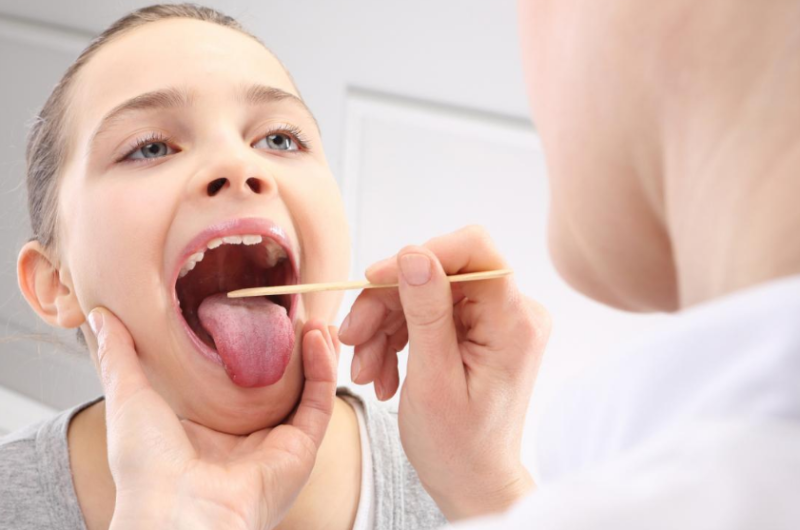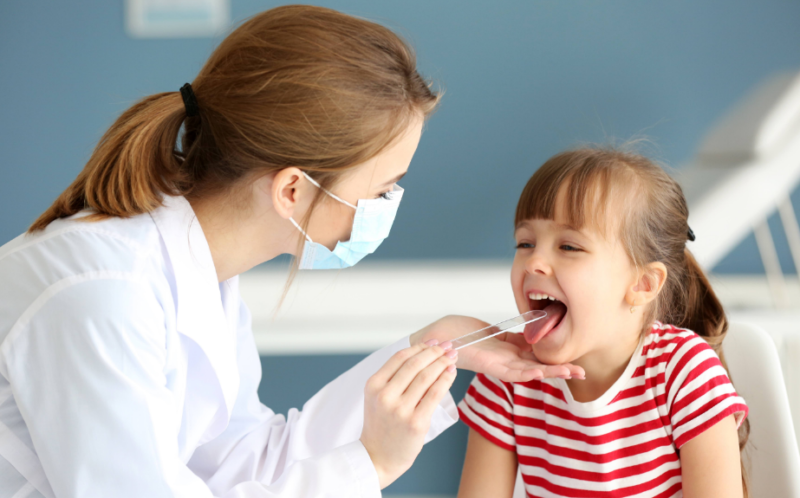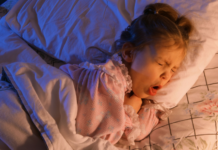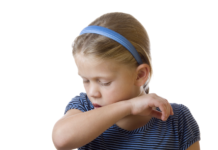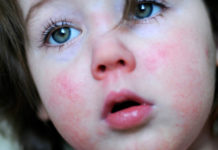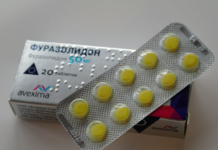With the development of pharyngitis in children, the tissues of the pharynx become inflamed. The task of parents is to exclude risk factors for the disease, recognize the initial clinical signs in time, and prevent the development of a chronic form.
Material Content:
What is pharyngitis
Inflammation of the pharynx is often associated with acute respiratory viral infections, respiratory tract infections, less often occurs as an isolated disease. The development of pharyngitis is caused by viruses, bacteria, fungi and allergens. The risk of inflammation increases with a decrease in local immunity due to constant irritation of the mucous membrane of the oropharynx.
Dysfunctional factors contribute to this:
- neglected diseases of the paranasal sinuses disrupt normal breathing, the child breathes cold dusty air through his mouth;
- posterior rhinitis, when mucus does not flow out through the nose, but along the walls of the nasopharynx;
- too hot, spicy, rough food;
- constantly dry, hot air in the house;
- pathological gastroesophageal reflux (the contents of the stomach are thrown back);
- abuse of drops from a cold;
- local hypothermia;
- atrophic tissue change after removal of the tonsils.
Pharyngitis is sick at any age, but more often - babies up to 7 - 8 years old.
Types and forms of the disease
By etiology, children are diagnosed with 4 types of oropharyngeal inflammation:
- viral cause adenoviruses, rhinoviruses, influenza viruses, cytomegaloviruses;
- bacterial often provoke pneumococci, streptococci;
- fungal occurs when infected with Candida fungi;
- allergic develops when sedimentation on the surface of the pharynx of irritants: dust, wool, pollen of plants, fumes of chemicals.
Acute inflammation begins after exposure to the pathogen, accompanied by vivid symptoms. The chronic form develops with delayed or careless treatment, proceeds with alternating exacerbations and remission.
Against the background of constant adverse factors, chronic pharyngitis develops as an independent disease, not associated with infections and allergens.
According to morphological changes, the depth of the lesion, the following types of disease are distinguished:
- Catarrhal - inflammation affects only the upper layer, accompanied by redness, swelling of the mucosa.
- Granular - the lesion extends to the lymphoid follicles, against the background of hyperemia, granular red nodules appear.
- Atrophic - inflamed tissues dry out, become thinner, this form is rarely seen in childhood.
By the area of the outbreak, common and limited pharyngitis is diagnosed. The first affects the entire oropharynx, including the posterior wall, the second - the lateral rollers.
Symptoms and features of the course in children
The acute inflammatory process of a viral, bacterial etiology is accompanied by the following clinical symptoms:
- the temperature rises to 38 - 38.5 ºC;
- cough appears, which intensifies at night, the first 3 days are dry, then wet;
- there is pain when swallowing, sometimes it gives to the ears;
- the surface of the pharynx turns red, swells, granular pharyngitis is accompanied by granular formations;
- lymph nodes increase;
- the voice wheezes;
- if the disease develops against the background of the flu, there is a headache, runny nose, sometimes conjunctivitis;
- with bacteria, purulent accumulations on the glands often form;
- with a fungal form, the oropharynx is covered with white coating, cracks appear in the corners of the lips.
Parents sometimes confuse pharyngitis and acute tonsillitis, but these diseases have differences. With tonsillitis, the palatine tonsils enlarge, redden and become corked, there is no cough, the throat hurts more, but the mucous throats do not change.
Symptoms of pharyngitis in children under 2 years of age are more pronounced, more painful. The younger the baby, the more severe the inflammation. In infants, the onset of the disease is recognized by changes in behavior. The baby does not sleep well and eats, constantly spits up after feeding, often cries, coughs, he develops fever up to 39 ºC.
In a chronic course, the listed symptoms appear only at the stage of exacerbation; during remission, the disease resembles tickling, dry throat, and sometimes coughing. Inflammation of allergic etiology occurs against a background of normal temperature or a slight increase to 37 - 37.5 ºC, accompanied by dry cough, sometimes painful sensations when swallowing, runny nose.
Diagnostic measures
A child with signs of pharyngitis is taken to a pediatrician or otolaryngologist. The disease is easy to diagnose based on external symptoms, complaints of the child and parents.
The causative agent is identified by the results of a clinical blood test and a study of a smear of the mucous membrane of the oropharynx nor microflora and sensitivity. Sore throat - an early symptom of measles, scarlet fever, laboratory tests help rule out or confirm these infections.
Methods for treating pharyngitis in a child
More often than not, the child is left to be treated at home, before bedding is restored to normal temperature.
The pace of recovery depends on proper care:
- In the nursery, humidity of 50 - 70% is maintained, regularly ventilated.
- Dust removed daily.
- The small patient is abundantly watered with warm water, compote, fruit drinks, rosehip broth, tea.
- They feed with semi-liquid warm food, rude, hot, cold, sour foods are excluded.
Treatment of acute pharyngitis in children is limited to external drugs and traditional medicine.
For rinsing or irrigation of the throat, apply:
- a solution of soda or sea salt (1 tsp. in a mug of warm boiled water);
- decoctions of chamomile, calendula;
- Miramistin;
- "Rotokan";
- Eludryl;
- "Chlorophyllipt";
- “Aqualor” for rinsing with extract of aloe and chamomile;
- "Bioparox."
The listed funds can be mixed with saline and inhaled. To avoid burns, use a nebulizer. Additionally, antimicrobial tablets, Grammidin, Faringosept, Strepsils, Septolete, and Doctor Mom lozenges are allowed to dissolve. In case of inflammation of an allergic nature, the irritant is detected and eliminated, antihistamine drops are used: “Fenistil” is allowed from 1 month, “Zirtek” - from six months.
During treatment, observe the following precautions:
- The spray can not be used until the baby understands the word, does not know how to hold his breath on command. During injection, the medicine may cause tracheal spasm, choking.
- To medicines based on iodine, for example, "Lugol" pediatricians are ambiguous. Iodine safely fights bacteria, but severely injures the mucous membrane, slowing recovery.
- Antibiotics in the form of tablets, injections are prescribed only for damage by bacteria with the spread of infection to neighboring organs. With the viral form, they harm.
- If the baby has not learned to gargle, an antiseptic is injected with a syringe. Previously, the child is laid to one side or tilted forward so that the liquid flows freely from the mouth.
- Inhalations are excluded if the baby has a temperature above 37.5 ° C.
Grudnichkov is treated with the following means:
- Watered with a warm broth of chamomile.
- The oral cavity is treated with solutions of Derinat, Miramistin, they are allowed from birth. They infiltrate gauze with an antiseptic, wrap them on the little finger, carefully wipe the tongue, the inner surface of the cheeks, the medicine with saliva falls on the site of inflammation.
- “Aqualor Baby” is instilled into the nose. Saline solution flows down the nasopharynx to the lesion site.
In the chronic form, pediatricians recommend eliminating unfavorable factors in order to reduce the number of exacerbations and prolong remission. With a strong proliferation of lymphoid tissue, the granules are removed with a laser, radio waves, cauterized with silver nitrate or liquid nitrogen.
Possible complications and consequences
With a delayed treatment of acute inflammation or against the background of advanced pharyngitis, the infection affects neighboring organs.
The following diseases develop:
- follicular tonsillitis;
- pharyngeal abscess;
- laryngitis;
- tracheitis;
- bronchitis;
- damage to the inner part of the ear;
- lymphadenitis of the neck;
- paratonsillar abscess.
In children 5-12 years old, a systemic complication of post-streptococcal glomerulonephritis - damage to the kidneys develops.
Disease prevention
You can reduce the risk of inflammation in the following ways:
- Maintain a favorable microclimate in the house: humidity - 60%, temperature - air 20 - 22 ºC.
- During seasonal influenza epidemics, ARIs have fewer crowded locations. Before leaving the house, treat the inner surface of the nose with Oxoline ointment. Rinse your mouth with herbal decoctions with antiseptic properties.
- Do not send a cold baby to school or kindergarten.
- Do not disrupt the vaccination schedule.
- To harden the throat: first rinse with water at 30 ºC, gradually reducing to 15 - 17 ºC.
- In time to treat inflammatory foci of the oral cavity: tonsillitis, stomatitis, caries.
Pharyngitis in a child passes in 1 - 2 weeks, if favorable conditions are created, and the recommendations of the pediatrician are followed.


